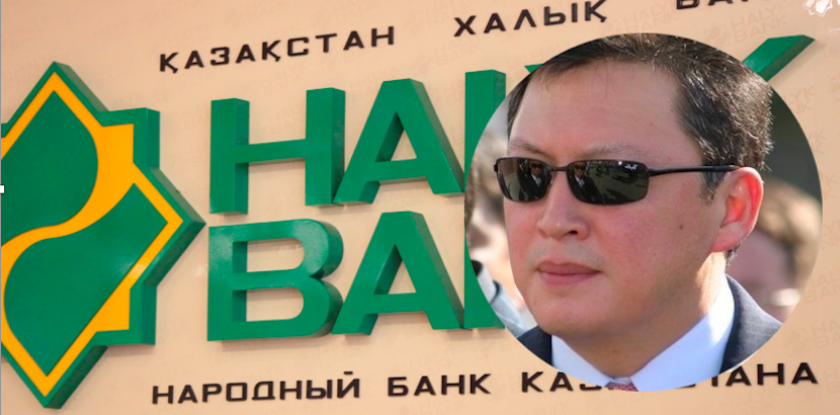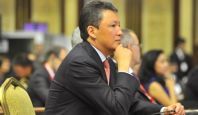Reflecting upon the subject of a possible growing animosity between Nursultan Nazarbayev’s eldest daughter Dariga and his son-in-law Timur Kulibayev, we have come to a conclusion that the future privatization of KazMunaiGas JSC NC will become one of the major causes for the friction. To be more precise, the friction will lie in selecting who is to run Akorda’s special operation and become its main shadowy beneficiary.
In view of this, we have taken note of Timur and Dinara Kulibayevs’ intention to sell a part of Halyk Bank, Kazakhstan’s biggest and most valuable financial institution that they control.
The fact that Holding Group ALMEX JSC, following the numerous requests of the investors community, announced reviewing the options for injecting the liquidity of Halyk Bank’s shares including a possibility of their partial sale on the stock-market was first revealed in the press-release published on the KASE (Kazakhstan Stock Exchange) official website.
Even though the press-release stipulates that «all the options will be reviewed with due regard to the beneficial market conditions» and «with that, ALMEX is to retain the controlling stake in Halyk Bank», the intention of the billionaire couple, Timur and Dinara Kulibayevs, whose combined fortune, according to Forbes, constitutes US6.2 $ surprised many. Especially since there is no need for the bank’s major shareholders to sell a part of their portfolio.
Note that Kazakhstan’s biggest private bank has branches in Russia, Kyrgyzstan, Georgia, Tajikistan and, starting this May, in Uzbekistan. Its major shareholders include Holding Group ALMEX JSC — 73,6% (Timur and Dinara Kulibayevs), Unified Accumulative Pension Fund JSC — 6,5%, GDR — 16,8%, other shareholders — 3,1%. And, on May 13, 2019, S& P Global Ratings affirmed its ‘BB’ long-term and ‘B’ short-term issue credit rating on Halyk Savings Bank of Kazakhstan (Halyk Bank); outlook stable.
Here are some key passages from S& P’s statement (text in bold by kz.expert).
«… The bank has a prudent liquidity management policy and enjoys strong customer loyalty. We therefore expect it to keep its ample liquidity buffers, despite challenging conditions in the Kazakhstan banking sector, and revise our assessment of the bank’s standalone credit profile (SACP) to 'bb' from 'bb-'. This forecast is supported by the bank’s lack of large debt repayments due in the medium term and conservative lending strategy. In addition, we note that a significant part of the bank’s liquid assets consist of local sovereign and central bank exposures. We estimate liquid assets currently account for 49% of the bank’s total assets and will not decrease below 40% over the next two years. Net broad liquid assets covered 77% of short-term customer deposits as of Jan. 1, 2019, which is a significantly higher level than local peers.
Halyk Bank dominates the Kazakhstani banking sector in terms of both retail and corporate customer deposits, with market shares of 37% and 39% respectively as of April 1, 2019. It is historically known as the country’s savings bank and considered a safe harbor during periods of turmoil in the local market. This was the case in 2018, when Halyk Bank’s customer funding continued to grow despite some closures to optimize the branch network after the integration of Kazkommertsbank (KKB). Halyk Bank’s stable funding and long-term funding ratios were 198% and 99% respectively at end-2018, which is better than the indicators reported by the majority of peers.
We continue to consider Halyk Bank highly systemically important in the Kazakhstan banking sector. However, we no longer incorporate any support in the bank’s issuer credit rating because its intrinsic creditworthiness is now closer to our 'BBB-' sovereign local currency rating on Kazakhstan.
Halyk Bank benefits from an experienced management team, which has demonstrated stable financial performance over the economic cycle. We expect the bank to maintain a risk-adjusted capital (RAC) ratio of 7,7%-8.3% over the next two years, supported by sound earnings, and a balanced dividend policy».
Thus, if we are to believe S& P Global Ratings, Halyk Bank is a systemically important financial institution with a professional management team, a gigantic (by the Western standards) liquidity buffers, reliability and earning capacity reserves.
If all of this is true, why then Timur and Dinara Kulibayevs have decided to sell a part of their shares? In order to, „following the numerous requests of the investors community“, satisfy the demand of the market? But why have all these numerous requests been heard by Hayk Bank’s major shareholders only now and not, say, two or three years ago, before the acquisition of Kazkommertsbank?
We allow for the possibility that the cause of Timur and Dinara Kulibayevs’ abnormal sensitivity to the „numerous requests of the investors community“ lies in the fact that Halyk Bank’s financial standing is, in fact, significantly worse than it appears on paper.
We remarked on the existence of this possibility when commenting on BTA Bank’s and Kazkommertsbank’s rescue operations. Moreover, we are certain that Akorda saved Qazkom only for the purpose of pumping a gigantic sum (about 2.4 trillion tenge of the state budget money) into the bank belonging to Nursultan Nazarbayev’s second daughter and her husband.
S& P’s statement confirms this indirectly in the following paragraph:
«That said, we believe that Halyk Bank is exposed to significant legacy problem assets stemming from the acquisition of KKB in 2017. The volume of problem assets--classified as Stage 3 and purchased or originated credit impaired (POCI) under International Financial Reporting Standards (IFRS) 9--is still high at about 19,6% of total loans at end-2018, down from 27,2% of total loans at end-2017. However, the bank’s loans overdue by more than 90 days decreased to about 8,2% of total loans at end-2018, from 12,1% a year before. Furthermore, we believe the bank has better interest collection than Kazakhstani peers, demonstrated by its interest-received-in-cash-to-interest-accrued ratio of about 94% in 2018. Loan loss provisions cover Stage 3 and POCI loans by 44%, which is similar to the average level of Kazakhstan-based banks».
We are not to estimate how many Halyk Bank’s shares will be put out for sale, who will buy them and at what price. However, we are definitely talking about hundreds of millions of dollars here for, as of this writing, the bank’s market value constituted US3.3 $ bln.
In other words, if Holding Group Almex sells 15% of the shares while retaining 50,11% of the stock, it will receive about US0.5 $ bln without including the premium.
We will leave the question of why Timur and Dinara Kulibayevs have suddenly found themselves in need of such a substantial sum open. Theoretically, this money can be -
- moved abroad in order to ensure the financial independence of the family from the other Akorda’s inhabitants including Dariga Nazarbayeva and Karim Masimov,
- spent on acquiring foreign assets that will be inaccessible (at least directly and immediately) for the Kazakh authorities,
- used for purchasing KasMunaiGas’ shares
- transferred to the people on whom Timur and Dinara Kulibayevs depend.
On course, anyone who wants to do so can trust the words of Halyk Bank’s Chairperson Umut Shayakhmetova who, on May 17, 2019, commented on the subject in her Forbes interview. Although, in our opinion, the information presented by Ms. Shayakhmetova speaks to the fact that her employers are trying hard to „pump up“ the investors so that the latter will buy the bank’s shares.
Not to be flimsy, let us quote from this publication.
«Meanwhile, the Chairperson of Halyk Bank commented on the company’s decision on the maximal dividend payout at year-end of 2018. Note that the general meeting of the bank’s shareholders held on April 18 allocated 50% of the net profit to be paid as dividends which is the normative «ceiling» allowed by the company’s dividend policy.
Shayakhmetova explained that the maximal dividend payout is determined on the basis of the financial results. And the current financial standing of the bank allows to pay the maximal dividends. Nonetheless, she noted that the outside shareholders are displeased with the fact that the dividend ceiling is limited to 50% when the bank is generating a big net profit volume. For instance, in 2018, the bank’s net profit increased by 46% constituting 253.4 bln tenge. In 2017, the net profit increased by 32% reaching 173.5 bln tenge.
The net profit growth has allowed the bank to distribute more funds among the shareholders. If, at year-end of 2017, the dividend payout constituted 6.3 tenge per share, then, at year-end of 2018, it reached 10.7 tenge per share. The outside shareholders of Halyk Bank suggest eliminating the ceiling limit of the dividend payout».
Let’s wait and see what becomes of it.
To be continued
NOTE FROM EDITOR: this is the fourth article of a series of publications on the latest redivision of the Kazakh economy for the benefit of the First President’s family.






